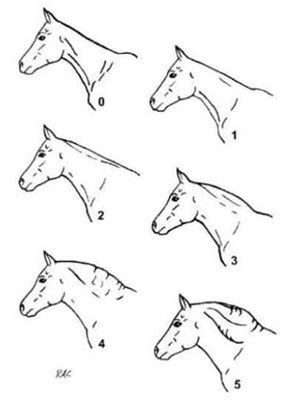 Credit: Courtesy University of Minnesota
Credit: Courtesy University of MinnesotaStudies conducted by numerous researchers have all shown the same thing: the number of horses that are overweight is on the rise. A horse that is overweight has a much higher risk of developing laminitis, insulin resistance and other metabolic disorders. There are a number of tools that horse owners can use to help determine if their horse is overweight.
1. Body Condition Score: Researchers from Texas developed the body condition scoring system in 1983, which is an evaluation of subcutaneous fat (palpable, under the skin) over six points on the horse; the neck, withers, behind the shoulder, along the back, rib area and the tailhead. Horses are body condition scored on a range of 1 (poor) to 9 (extremely fat). The ideal BCS for most breeds and disciplines is a 5, but ranges from 4 to 6. Horses with a body condition score of 7 or above are considered overweight.
2. Girth:Height Ratio: The girth to height ratio has been shown to be useful in estimating overall adiposity and is well correlated to body condition score. To calculate, simply divide the girth measurement by the height measurement. Both measurements should be taken at the top of the withers. A horse would be considered overweight if the Girth:Height ratio is equal to or greater than 1.26. A pony would be considered overweight if the Girth:Height ratio is equal to or greater than 1.33.
3. Cresty Neck Score: Similar to the body condition scoring system, the cresty neck score is an evaluation of the amount of fat in the neck region. Research has shown that horses with cresty necks may be more prone to metabolic disorders. The cresty neck score ranges from 0 to 5. 0 indicates no visible appearance of a crest, whereas a score of 5 indicates a crest so large that it droops to one side. Owners should aim to keep their horses at a cresty neck score of 2 or lower. A score of 3 or greater would be considered a cresty neck and a horse that is likely overweight and prone to metabolic disorders.
 Credit: Courtesy University of Minnesota Cresty neck scoring system (from Carter et al., 2009).
Credit: Courtesy University of Minnesota Cresty neck scoring system (from Carter et al., 2009).4. Ideal Body Weight Equations: There are several equations that owners can use to estimate horse body weight without a scale. This is important and helps when determining doses of medications and dewormer, but what should a horse weigh? Researchers at the University of Minnesota have recently developed ideal body weight estimation equations to help owners assess if their horse is either underweight or overweight. By using the equations below, or by entering measurements in the Healthy Horse app (available for both Apple and Droiddevices), horse owners can calculate their horse’s ideal body weight based on breed type, height at the top of the withers and body length measured from the point of shoulder to a line perpendicular to the point of the buttock (do not wrap the tape measure around the buttock). Ideal body weight can then be compared to actual (or estimated) body weight and a nutrition program can be tailored to achieve body weight maintenance, loss or gain.
Arabians, Stock Horses and Ponies
Ideal body weight (lbs) = [(15.58 x height in inches) + (23.52 x body length in inches) – X]. X = 1,344 (Arabians), 1,269 (stock horses), or 1,333 (ponies)
Draft Horses and Warmbloods
Ideal body weight (lbs) = [(27.55 x height in inches) + (25.98 x body length in inches) – X]. X = 2,092 (draft horses) or 2,235 (warmbloods)
In conclusion, body condition score, girth to height ratio, cresty neck score and ideal bodyweight equations can all be used to help horse owners determine if their horse is overweight or obese. If more than one of these methods indicates an equine is overweight, the owner should work with an equine nutritionist and veterinarian to devise a body weight loss program.
Sign up for the University of Minnesota horse newsletter.





